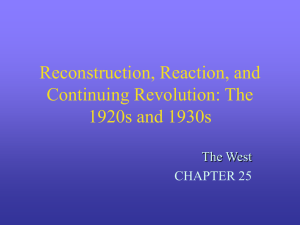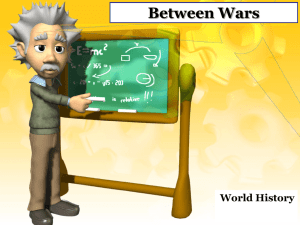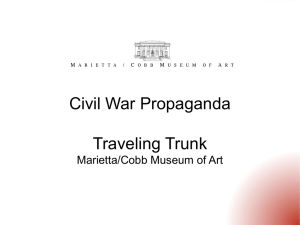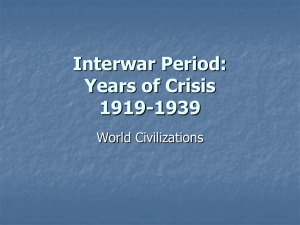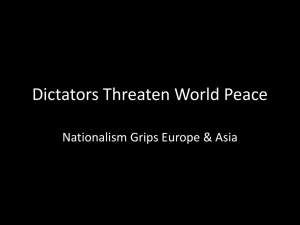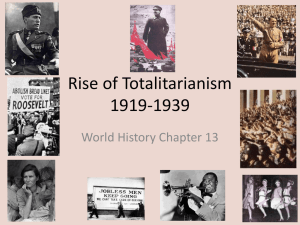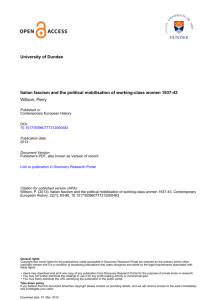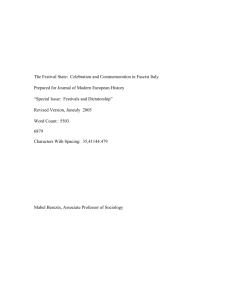How did Mussolini use propaganda to strengthen his regime?
advertisement
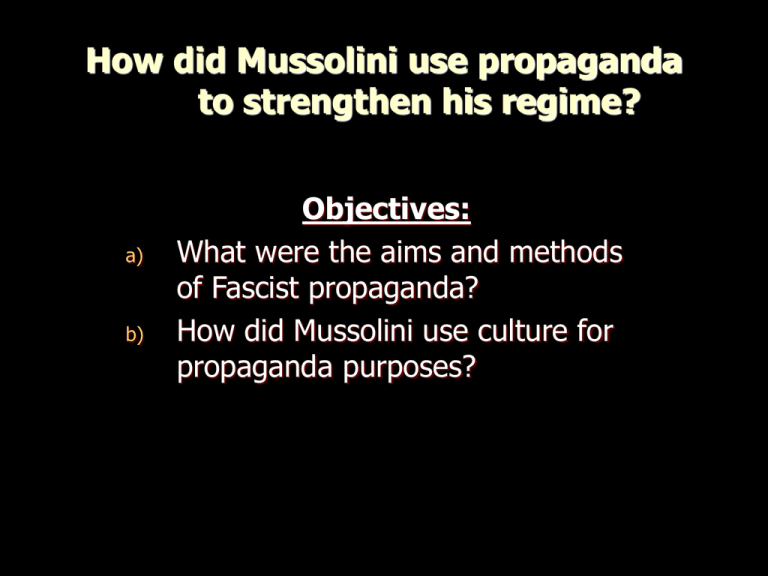
How did Mussolini use propaganda to strengthen his regime? a) b) Objectives: What were the aims and methods of Fascist propaganda? How did Mussolini use culture for propaganda purposes? How did Mussolini use propaganda to strengthen his regime? How did propaganda develop in Fascist Italy? Summary Mussolini = journalist Newspapers were the most important information and propaganda instrument Radio and film = slow start but then = major propaganda tool especially newsreels Enthusiasm vast parades and sporting activities Technology Difficult for fascist regimes to exist without technology? Microphone and loud speaker = voice to the masses Architecture used to impress people = reinforced concrete, improved transportation for massive pieces of stone Electrification, planes, railways, cars and tanks all in their way gave added power to the regime How did propaganda develop in Fascist Italy? Analysis Development = gradual process Press office gradually extended its original role in the 1930s to cover radio, film and eventually all aspects of culture. 1937 Ministry of Popular Culture nicknames ‘minculpop’ limited effect? Due to bureaucratic inefficiency Failure to win popular support for German alliance and government’s anti-Semitic policies in the late 1930s _____________________________ Most Italians believed, and some still do despite evidence to the contrary, that Fascism reduced crime, vice and poverty 3. What were the strengths and weaknesses of the major means of propaganda in spreading the Fascist message? Newspapers • By 1926 the last opposition party papers suppressed • Many bought by fascist sympathisers • Hostile editors or journalists could be arrested or replaced • Most popular journalists remained in their posts = reinforced readers acceptance of what they said. • Govt. grants favoured journalists/papers • State controlled what papers said • Most censorship by editors • Reporting of crime, disasters, unemployment, disorders etc forbidden • Most foreign papers banned • One press agency = run by a fascist • Compulsory – Journalists = registered by state and join fascist organisation ________________________________________ • Fascist party papers = no more than 10% of overall circulation. Vatican’s paper increased it’s daily circulation. Milan’s paper = 5 times Fascist circulation • Underground anti-fascist papers continued What were the strengths and weaknesses of the major means of propaganda in spreading the Fascist message? Radio Neglected initially, post 1924 state run rapidly expanding radio network Music – classical, US jazz, and drama Mussolini’s major speeches broadcast live large loudspeakers – piazzas Private radio listeners – foreign programmes, BBC, Spain Radios expensive .’. Few had them More listened in public 1930s govt. provided sets for a new rural agency (ERR) – schools OND ran community listening meetings which helped spread fascist ideas, especially in rural areas and to the illiterate What were the strengths and weaknesses of the major means of propaganda in spreading the Fascist message? Cinema Govt. slow to realise it’s potential 1924 LUCE created – produce newsreels & documentaries. M previewed them! Shown before main film Censored Italian 7 imported films Autarky principle for film industry too – restricted Hollywood imports – subsidies 1937 IRI – Hollywood by the Tiber! Revival of domestic films Most films escapist/historical drama, few explicitly fascist – few propaganda films Cinema offered escapism, false sense of security and national pride What were the strengths and weaknesses of the major means of propaganda in spreading the Fascist message? Posters Most visual means of propaganda Many walls plastered by the party and govt agencies with simple slogans and striking images of the Duce. Important as there was considerable illiteracy. Occasionally, opposition posters were displayed briefly, but generally the govt. had a MONOPOLY of this important medium. Mass activities The Italian team that went on to win the world cup, 1934. The sign at the back of the stadium reads ‘Buy Italian products’ How did Mussolini use culture for propaganda purposes? Objectives: 1. Why was there considerable cultural diversity in Fascist Italy? 2. How effectively were the Arts and culture used for propaganda purposes? How did Mussolini use culture for propaganda purposes? What is culture? Elitist works of art High culture - intellectual discussion. Mass culture – popular customs and behaviour Mussolini most concerned with mass culture Modern means of communication = more opportunity to reach and influence masses more effectively. High culture used as a means of propaganda & to increase the external prestige of the Fascist state Was there an official view of Fascist Art? 1. What do sources 6.19 & 6.20 tell us about the Fascist regime’s view of art? Control The government tried to control art through promoting competitions, at regional, national and international level. Winners received govt. funds and commissions Private commissioning largely unaffected…. until late 1930s. Artists expected to join the Syndicate of Professionals and Artists. _________________________________ Artists were not required to subscribe to an official view of art. This meant that unlike Nazi Germany, Fascist Italy experienced no loss of major artists. Literature, Drama & Music Less attention did not reach the masses. Drama = minority pursuit despite efforts of National Fascist Culture Institute. Conferences, free concerts & publications. Music = less potential for direct propaganda musicians required to join the Fascist Union of Musicians. Encouraged to reject foreign influences and develop ‘cultural AUTARCHY’. However, considerable diversity was still maintained. In theory Ministry of Popular Culture was supposed to control music but in practice music escaped major regimentation Literature, Drama & Music - Analysis No great fascist literature was every written Provided writers included nothing directly hostile to the regime, they were left free, apart from being required to join the relevant Fascist syndicate The poet Eugenio Montale probably spoke for many when he explained, ‘ I never was Fascist, nor did I sing to Fascism. Nor however, did I write poems that might appear to oppose that pseudo-revolution’ Philosophy and Intellectual Ideas Mussolini was particularly concerned to develop a philosophy of Fascism. He considered this would boost the regime’s international reputation, and help establish a new Fascist elite. Communism = Writings of Marx and Lenin. Nazism = Mein Kampf. Fascism = nothing! Mussolini wanted to form a clear doctrine of Fascism. 1925 over 200 intellectuals met at Bologna to produce the Manifesto of Fascist intellectuals. ‘Without fascism there can be no true culture!’ Counter Manifesto declared fascism and culture incompatible. Philosophy and Intellectual Ideas - Analysis The attempt to intellectualise the diverse & contradictory ideas in the Fascist movement had little impact. Amongst the educated, Fascism was seen primarily as a vehicle for career advancement rather than intellectual inspiration. Most intellectuals were not committed Fascists Famous philosopher Croce retained his influence – critical of regime – government took little action. Catholic Church still influential student’s federation & Catholic University in Milan. Italian intelligentsia, though politically conformist, did not become intellectually engaged with the regime. The historian Zaggario has argue that ‘Italian academic culture was largely impervious (resistant) to Fascistisation’

